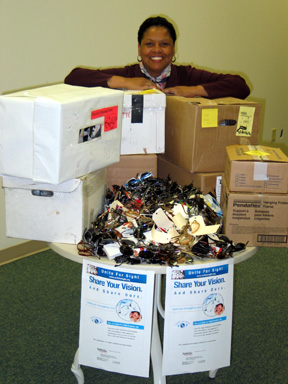 |
Valda Boyd Ford with some of the 1,200 pairs of eyeglasses that were donated for her trip to Ghana. Optometrists across the city volunteered to read the glasses and determine their prescription. |
Ford, director of UNMC’s Community and Multicultural Affairs, will spend a total of eight weeks working with Unite for Sight, an organization dedicated to health promotion and disease prevention. In addition to promoting eye care, Ford said the experience would give her a better understanding of the refugee culture. Nebraska has one of the largest Sudanese populations in the United States and Omaha has seen the recent arrival of Somali Bantu refugees.
Since her arrival, Ford has kept in touch with UNMC colleagues via e-mail, thanks to an Internet cafe near her “hotel” bungalow. UNMC Today will share some of Ford’s experiences at the Buduburam Refugee Camp, beginning today with some of her initial observations.
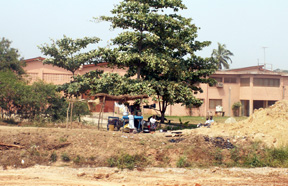 |
“A snapshot of the way everything looks: brown, parched, rutted,” Ford writes. |
The people are very friendly even though the conditions in the refugee camp are very difficult. I am looking forward to knowing them and learning more about their culture over the next two months.
E-mail dated Jan. 9 — Arriving at the camp at Buduburam at night I wondered if it was a good or bad thing that I could not see my surroundings.. I unpacked enough to find my mosquito net, washed off the travel dirt with a wet cloth and climbed into bed. I wondered if I could get to sleep but, before I knew it, I was awakened by competing calls for prayer. It was about 5:30 a.m.
As I got up and went outside I saw stark contrasts. The hotel had a neat arrangement that would have fit in at a resort on Bali or Fiji or any Caribbean Island getaway. But, beside the hotel, people lived in very cramped and, frequently, very unsanitary conditions. Women threw pails of water (or something) into the paths between the houses, children aged 4 or 5 washed themselves in what could minimally be called a yard – their nakedness startling to me but ignored by all others.
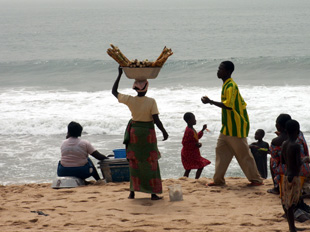 |
At Cape Coast, Ghana, a woman in traditional garb carries her wares on her head, while another young man wears Western garb. The ocean is treacherous and too dangerous for swimming, Ford writes. |
I received a few stares as I made my way, in a T-shirt and slacks, to the Internet cafe, which is, wonderfully, only about one-tenth of a mile from the hotel. I wasn’t sure why I was being watched. After all, I am an African-American woman in an African land. No, I am told. You are not African-American. You are an American. Oh well, we’ll see how that goes.
Using the Internet cafe is a breeze and there is broadband access rather than dial-up. I am told that Ghana was the first country in Africa to have Internet capacity and the set-up is another stark contrast. The power in my room is via generator but this cafe has “regular” power and is open 24 hours a day. Of course there is usually a one-hour or greater wait to buy time online but the cost is negligible (for me, but not for the residents).
I decided to walk around the camp with my new vision partner – Cathlene. Cathlene has worked in South Africa and, while there, stayed with two host families – one white and one black. Her stories are wonderful and inspire me to be more adventuresome.
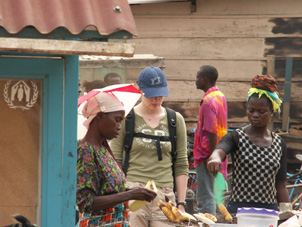 |
Cathlene buying barbequed corn. |
Walking is a bit treacherous. Obviously someone, at some point, put some thought to carving out roads through the camp but, the Liberians have been here for over a decade and, for several years, they have had little to no support from United Nations High Commission on Refugees (UNHCR). So the dirt roads with rain, wear, and any number of oversized vehicles have become uneven and challenging for this slightly less than agile demi-centenarian. Additionally, there are “things” in the road like old plastic bags, discarded paper, and flattened mouse carcasses.
The day ended with a meet and greet with my new colleagues (though one has decided to stay at Humjibre – a small town near the coast of Ghana) and the leaders of the NGO called Self-Help Initiatives for Sustainable development. While I’ve been in the country for less than a day, and I am exhausted, I know that this experience will be enlightening and awe-inspiring. The spirit of the people is far different from what I expected. In the midst of desolation there is hope.
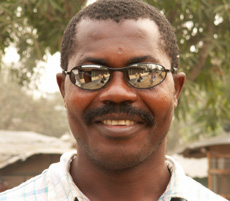 |
The man with a pair of donated sunglasses. |
Unfortunately, the worst was not over. Over time the other eye became infected and fighting for daily survival became the issue of the day. There was no money for medications and even if there was money, there was no mechanism to get them.
So he comes to me, to the most novice of novices, to ask for help. This is when I wish I was home with no more to worry about than which restaurant I will stop at for dinner. But, in the middle of this very dark cloud was a silver lining. A man who was a daily reminder to the refugees of the unspeakable horrors that forced them from their homes was able to regain, at least superficially, some ability to look like everyone else, to blend in, to be a part of the whole.
That came about because of the unselfish and extremely generous donations from the people of UNMC and the people of Omaha. I send a heartfelt thank you to my colleagues and friends for changing lives and enabling so many people to live a better life.